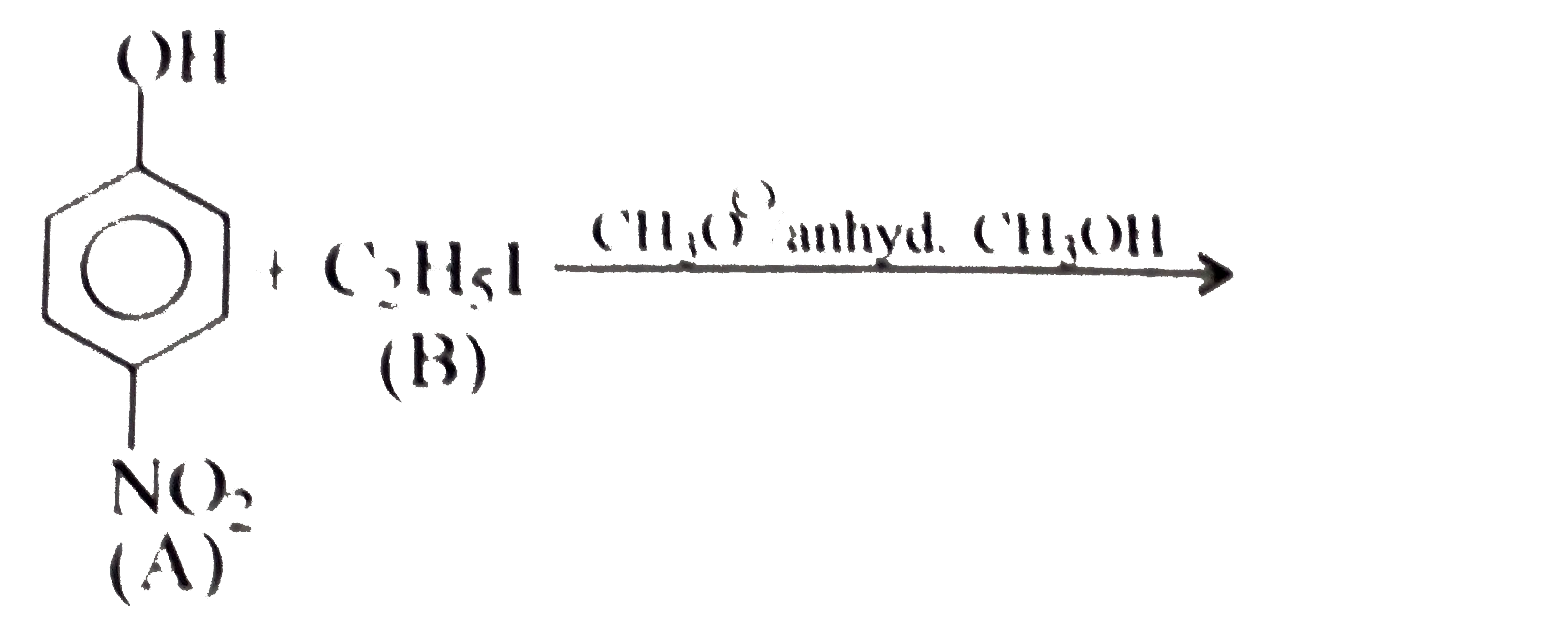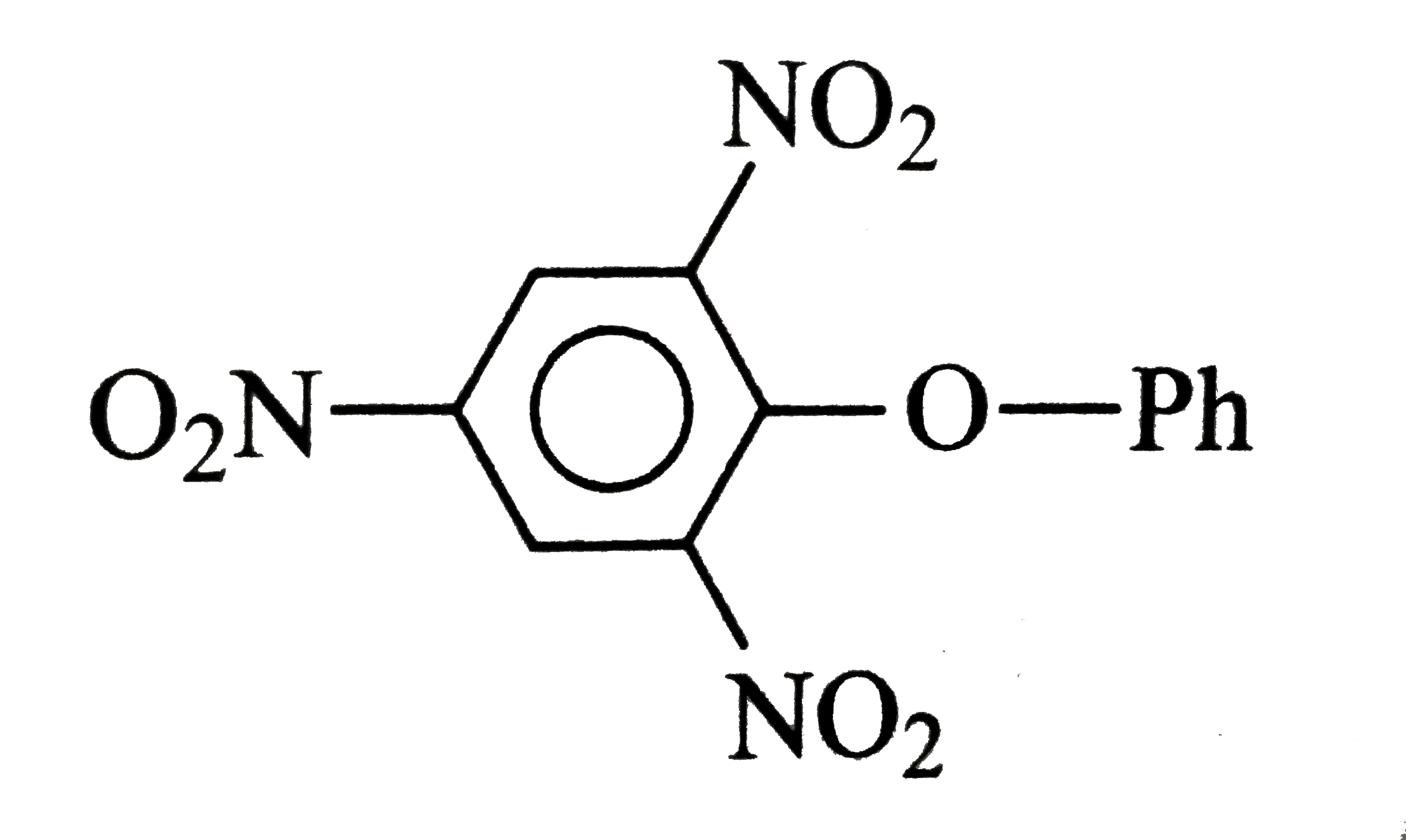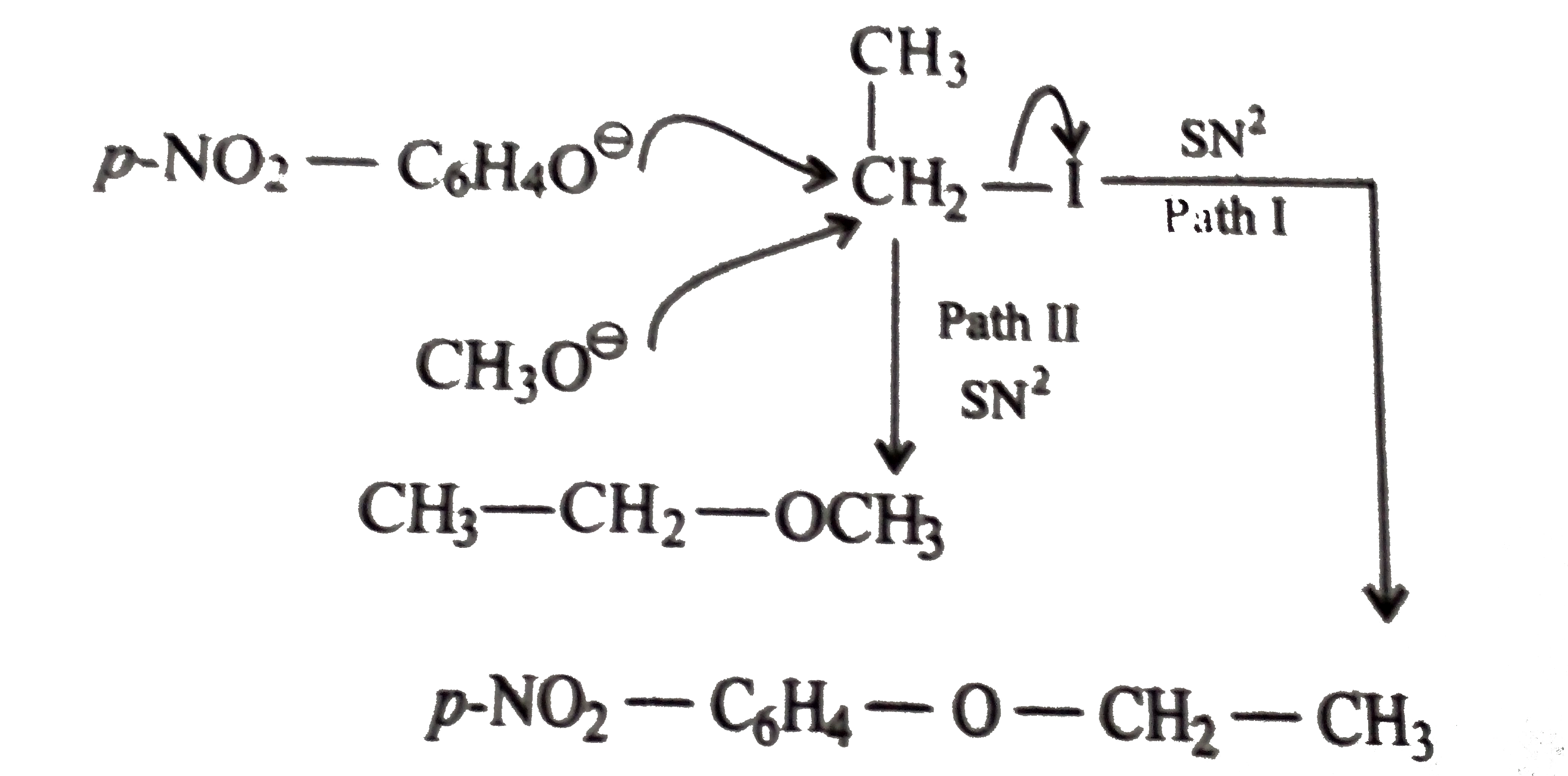Select the correct answer:
a. 
i. PhOC2H5 ii. Ph−−−O−−−Ph
iii. PhI iv. C2H5OC2H5
b. 
i. p−−NO2−−C6H4−−OC2H5
ii. p−−NO2−−C6H4−−O−−C6H4−−NO2−−p
iii. C2H5−−O−−CH3
iv. p−−NO2−−C6H5−−I.
c. 
i. C6H5CH2−−O−−Ph
ii. C6H5CH2−−O−−C2H5
iii. Ph−−O−−C2H5
iv. C2H5−−O−−C2H5
d. 
i. C6H5CH2−−O−−C2H5
ii. C6H5−−CH2−−O−−Ph
iii. Ph−−O−−C2H5
iv. C2H5−−O−−C2H5 .
e. 
i. 
ii. 
iii. 
iv. 
f. 
i. 
ii. 
iii. 
Video Solution
Text Solution
a. iv. C2H5O(−) acts as a base. It abstracts H⊕ form phenol to form PhO(−) ion.

C2H5O(−) is a stronger nucleophile than PhO(−). Hence, the product is obtained by path II. (Acidic character: PhOH>C2H5OH. (Basic and nuclepohilic character: PhO(−)<C2H5O(−))
iii. CH3O(−) acts as a base. It abstraacts H⊕ from p-nitrophenol to form p−NO2−−C6H4O(−).

CH3O(−) is a stronger nucleophile than p−NO2−−C6H4O(−), hence the product is obtained by path II. (Acidic character: p−NO2−−C6H4OH>CH3OH) (Basic and nuclepohilic character: p−NO2−−C6H4O(−)<CH3O(−))
c. ii. C2H5O(−) acts as a base. It abstracts H⊕ form PhOH to form PhO(−) ion. C2H5O(−)

d. i. PhO− acts as a base and it abstracts H⊕ form C2H5OH to form C2H5O− . C2H5O− is a stronger nucleophile than PhO^(-).<br><imga≤ocr_imageload∈g=lazysrc=https://d10lpgp6xz60nq.cloudfront.net/physics_images/KSV_CHM_ORG_P2_C12_S01_022_S04.pngwh=80%mx-autosty≤=background:white;><br>e.ii.PhO^(-)actsasabaseandit|t|ractsH^(o+)formp−nitrophenol→givep-NO_(2)C_(6)H_(5)O^(-).PhO^(-)isstron≥rνc≤oϕ≤thanp-NO_(2)C_(6)H_(5)O^(-)<br>(Acccharacter:p-NO_(2)C_(6)H_(5)OH gt PhOH)(Basicandνc≤oϕliccharacter:p-NO_(2)C_(6)H_(5)O^(-) lt PhO^(-))<br>Moreover,strongEWG∈(A)favoursArSNreaction.<br><imga≤ocr_imageload∈g=lazysrc=https://d10lpgp6xz60nq.cloudfront.net/physics_images/KSV_CHM_ORG_P2_C12_S01_022_S05.pngwh=80%mx-autosty≤=background:white;>f.ii.<imga≤ocr_imageload∈g=lazysrc=https://d10lpgp6xz60nq.cloudfront.net/physics_images/KSV_CHM_ORG_P2_C12_S01_022_S06.pngwh=80%mx-autosty≤=background:white;>actsasabaseandit|t|ractsH^(o+)omphenol→givePhO^(-).PhO^(-)isastron≥rνc≤oϕ≤thanO_(2)N  . Hence, the product is like in (e).
. Hence, the product is like in (e).
|
Topper's Solved these Questions
- ALCOHOL,PHENOL AND ETHERSBOOK - CENGAGE CHEMISTRYCHAPTER - ALCOHOL,PHENOL AND ETHERSEXERCISE - Solved Examples
17 Videos
- ALCOHOL,PHENOL AND ETHERSBOOK - CENGAGE CHEMISTRYCHAPTER - ALCOHOL,PHENOL AND ETHERSEXERCISE - Exercises Subjective
25 Videos
- ALIPHATIC AND AROMATIC ALDEHYDES AND KETONESBOOK - CENGAGE CHEMISTRYCHAPTER - ALIPHATIC AND AROMATIC ALDEHYDES AND KETONESEXERCISE - Archives Subjective
29 Videos
Similar Questions
Knowledge Check
The compounds CH3−O−C3H7 and C2H5−O−C2H5 exhibit
Aoptical isomerismBcis-trans-isomerismCmetamerismDchain isomerismCh3−O−C3H7andC2H5−O−C2H5 exhibit which type of isomerism
AMetamerismBPositionCChainDFunctionalIn the reaction
C6H5CHO+C6H5NH2→C6H5N→CHC6H5+H2O.
The compound C6H5N=CHC6H5 is known asAaldolBSchiff baseCSchiff's reagentDBenzedict's reagent
The major products that are formed by heating C6H5−CH2−O−C6H5 with HI
(A) 2C6H5I
(B) C6H5CH2IandC6H5OH
(C) 2C6H5OH
(D) C6H5CH2OHandC6H5I
View SolutionThe number of amines having pKb less than C6H5NH2 among the following is
P−CH3C6H5NH2,o−CH3C6H4NH2,m−CH3C6H4NH2,C6H5N(CH3)2,C6H5NHCH3,p−NO2C6H4NH2,p−CIC6H4NH2,C6H5CH2NH2
View SolutionArrange in order of boiling points :
(i) C5H5−O−C2,H5,C4H9COOH,C4H9OH
(ii) C3H7CHO,CH3COC2,H5,C2H5COOCH3(CH5CO)2O
View SolutionGive the common and IUPAC names of the following ethers :
(i)(CH3)2CH−O−CH(CH3)CH2CH3
(ii) ClCH2CH2−O−CH3
(iii) CH3−O−CH=CH2
(iv) p−NO2C6H5−O−C2H5
View SolutionIn the reaction : C6H5CHO+C6H5NH2→C6H5N=HCC6H5+H2O, the compound C6H5N=HCC6H5 is known as
View Solution
